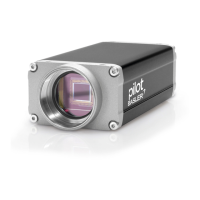Image Acquisition Control
102 Basler pilot
8.9 Maximum Allowed Acquisition
Frame Rate
In general, the maximum allowed acquisition frame rate for your camera can be limited by three
factors:
The amount of time it takes to read the data for an acquired image (known as a frame) from the
image sensor to the frame buffer. This time varies depending on the height of the frame.
Shorter frames take less time to read out of the sensor. The frame height is determined by the
camera’s AOI settings.
The exposure time for acquired frames. If you use very long exposure times, you can acquire
fewer frames per second.
The amount of time that it takes to transmit an acquired frame from the camera to your host
PC. The amount of time needed to transmit a frame depends on the bandwidth assigned to the
camera.
To determine the maximum allowed acquisition frame rate with your current camera settings, you
can read the value of the camera’s Resulting Frame Rate parameter. This parameter indicates the
camera’s current maximum allowed frame rate taking into account the AOI, exposure time,
bandwidth settings, and whether the averaging feature is enabled .
For more information about AOI settings, see Section 11.6 on page 163.
For more information about the Resulting Frame Rate parameter, see Section 5.1 on page 43.
For more information about the averaging feature, see Section 11.9 on page 173.
Increasing the Maximum Allowed Frame Rate
You may find that you would like to acquire frames at a rate higher than the maximum allowed with
the camera’s current settings. In this case, you must first use the three formulas described below
to determine what factor is restricting the maximum frame rate the most. Next, you must try to make
that factor less restrictive:
You will often find that the sensor readout time is most restrictive factor. Decreasing the AOI
height for the acquired frames will decrease the sensor readout time and will make this factor
less restrictive.
If you are using normal exposure times and you are using the camera at it’s maximum
resolution, your exposure time will not normally be the most restrictive factor on the frame rate.
However, if you are using long exposure times or small areas of interest, it is quite possible to
Note
When the averaging feature is used, an increased acquisition frame rate
can be achieved if the frame transmission is the most limiting factor. The
acquired images are not transmitted individually but will be used for
creating an averaged image. The averaged image will be transmitted at an
output frame rate which will be subject to the frame transmission time and
will be lower than the acquisition frame rate.

